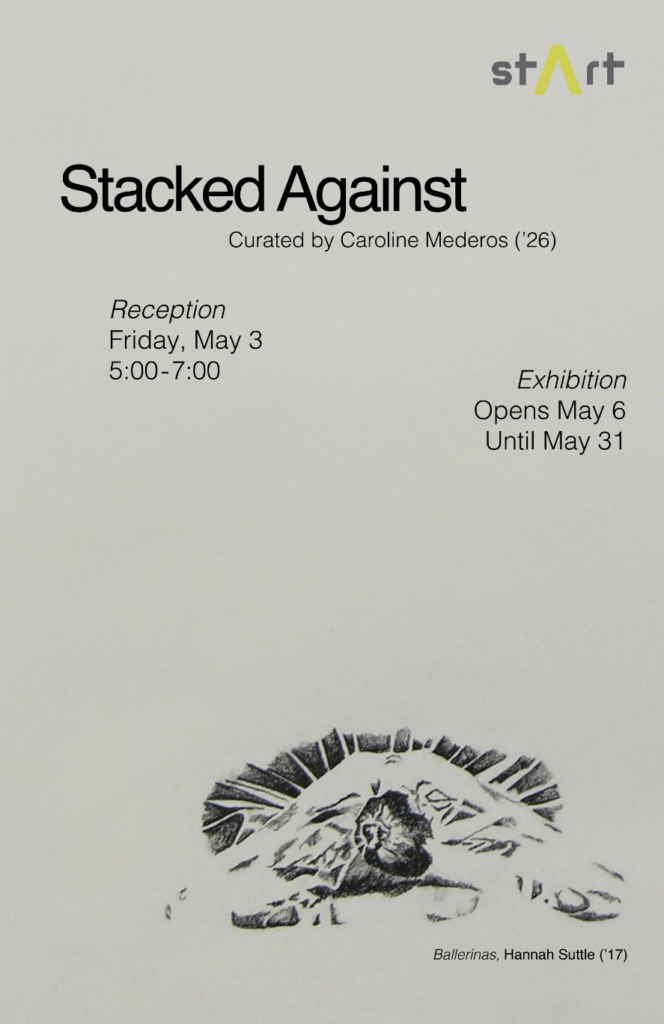Stacked Against

Stacked Against
Featuring works from the John P. Anderson Student Art Collection
MAY 6 – MAY 31
stArt.rv (Reynolda Village)
Curated by Caroline Mederos (’26)
What is perfection? As I selected these pieces, I kept returning to this question and searching for the answer in charcoal, watercolor, and paint, concluding that not only does it look different for everyone, but perfection, however, defined, shouldn’t be confused with perfectionism, which results from a person’s feeling of inadequacy to ever attain “perfection.” Perfectionism is what drives many students, including myself, to attempt to create an ideal projected image, an illusion that they have control over every aspect of their lives.
Perfection is by definition an unattainable goal. Despite the impossibility of achieving perfection, students at Wake Forest University often manufacture every aspect of themselves to project perfection. From meticulously curated Instagram feeds to presenting a consistently strong front every day to keep up the appearance of not drowning in responsibilities and endless deadlines, the students on this campus appear to be trying to achieve the impossible daily.
These artworks, curated from the John P. Anderson Student Art Collection, are meant to pull back the curtain on these constant attempts to project perfection across campus and give us a glimpse of realities that most are too afraid to show. The artists, hailing from a variety of backgrounds and identities, allow themselves to be vulnerable and illuminate the suppressed truth about not only being a student but coming of age in an environment where not having everything figured out is hardly ever discussed. Throughout the show, the idea of “perfection” is revealed by these student-artists as the inverse of perfectionism, in works that occupy a range of attitudes towards depiction, expressiveness, and resolution.
Three works from the exhibition exemplify these tendencies: Untitled by Yan Cheng, Untitled by Thomas Nash, and Ballerinas by Hannah Suttle. Untitled by Yan Cheng and Untitled by Thomas Nash contrast with each other in terms of appearing pristine. Cheng’s piece is a clean, resolved piece that captures the subject in precise detail and highlights every muscle, wrinkle, and wisp of hair. This drawing enhances the subject’s idealistic qualities. In contrast, while the subject is depicted with sufficient detail and precision in Untitled by Thomas Nash, it appears more relaxed and expressive to viewers. The residual charcoal marks that surround the rope offer a juxtaposition to the cleaner presentation of Cheng’s work. Despite both of these works being done in the same medium, they each occupy a place beyond perfectionism, comfortable with their advancement towards “perfection.”
Hannah Suttle’s Ballerinas encapsulates my thought process. Ballerinas work extremely hard to project perfection in their performances and move in ways that amaze the audience. The exhaustion of the ballerina in the second image mirrors the draining nature of keeping up the facade of perfection day in and day out. Furthermore, Suttle’s process of creating this piece mirrors the ballerina’s intense training as she would have to ensure that the charcoal left no stray marks outside of the figure and held herself to the same almost impossible ideas of perfection as the ballerinas to make a seamless finished product.
Overall the selected works reveal the struggles of what I believe to be a typical student experience. The artists in this exhibition, from my perspective, all have different ideas of perfection seen in how they present their work and what constitutes a “final product”. Some of the works appear technically perfect at first glance but after further inspection have slight imperfections such as stray marks and remnants of mistakes that were not fully erased, which I believe to be the epitome of the student experience. As students, we should not be forced to add this never-ending pressure of projecting the image of being perfect because it is not achievable, and we will exhaust our minds and become strangers to ourselves in the process. It is only when someone comes to terms with the fiction of “perfection,” as projected by perfectionist students, that they can move closer to an achievable perfection, where everything is perfect in its imperfection.
Reception
Friday, May 3rd @ 5-7 pm

